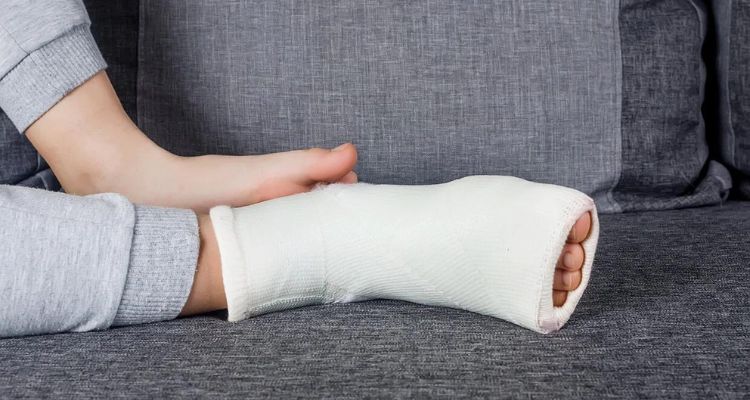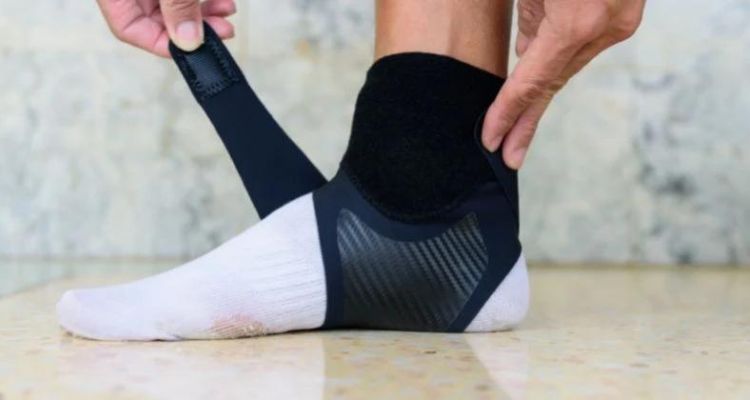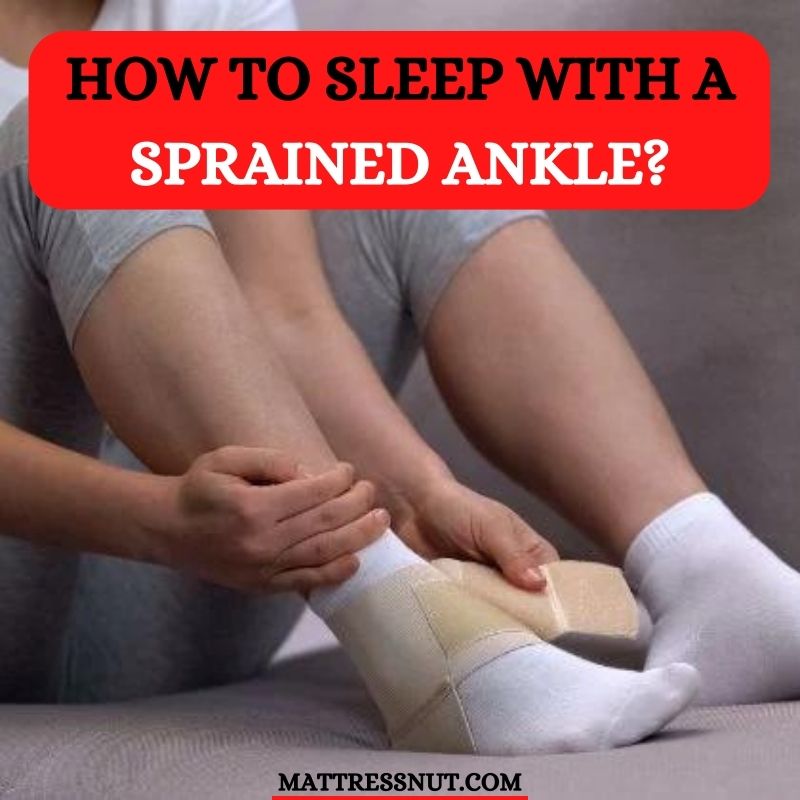You might have experienced different injuries while playing, exercising, or accidentally falling. A sprained ankle is an injury when your ankle is twisted into an uncomfortable and awkward position.
The ankle bones are tied together by the strong ligaments (tissues). These ligaments move in their way and range. If your ankle is driven awkwardly, these ligaments may sprain, tear off or stretch, resulting in a painful experience. You might see bruising and swelling in your ankle as well.
We will tell you what you can do with it, so it does not harm your sleep.
Tips to sleep with a sprained ankle
If you are dealing with pain in your ankle, you might face a tough time while sleeping. This may worsen the situation because you won’t recover without proper sleep.

According to NIH, sleep plays a crucial role in your injury recovery, whether a muscular injury or a bone injury. Go through the tips of sleep experts and doctors guiding you on sleeping well if your ankle is sprained.
Twisted ankle: first aid
As you know, a sprain occurs when the ligaments get slight or complete damage. These ligaments are responsible for keeping the ankle bones closely tight. It allows these bones to move within a specific range per their elasticity. When these ligaments are sprained, they get a partial tear or a complete tear-off.
If they damage partially, it’s a bit easier and faster recovery than a full ligament tear. But as the pain is unbearable in both cases, you must do first-aid before reaching a doctor.
Rest
The most effective thing to do is to do nothing. Yes, you heard that right because you have to relieve your ankle, so you don’t have to walk or move from your place. This is because if you try to walk and your ligament is completely torn, your ankle is going to swell, and thus the pain will increase.
The rest is extremely important, especially in the first 72 hours. However, you shouldn’t let it go until you feel your pain go away and your ankle feels well. There is no specific time for rest. You should rest until you get well.
Ice
You have to put some ice on your sprained ankle. You may wonder why we shouldn’t heat the ankle. Dr.Emily Harold at the University of Utah Health has answered your query very well. He says that Ice helps decrease your blood flow to the body part where it is applied, while heat increases blood flow. So, the injury may not swell comparatively when the blood flow is reduced.
This is why you should apply Ice on your ankle about 8 times a day or more in the first 24 to 48 hours, especially. Each session should be at least 15 minutes. Avoid exceeding the session time to prevent the ankle from freezing. Once you are done with a session, rest the ankle to rewarm it for a second session.
The best way to Ice the ankle is to pour water into a plastic bag and put some crushed ice. Cover this plastic bag in a damp towel and use it on your ankle.
Compression
The next important thing is to focus on the compression of your ankle. This reduces the swelling of your injury. This is to keep the ligaments relieved and tight in a single position motionless. This way, your ankle may recover faster than normal.
According to the NIH, compression plays an effective role in reducing swelling in tissue injuries. To do this properly, you must use an elastic bandage or wrap it around your ankle in a chevron pattern.
Ensure the bandage is tight and doesn’t create problems in blood circulation. Too tight might block blood circulation resulting in tissue damage. You should be doing this practice for a couple of days. You can put on compression bandages in the morning and put them off before going to bed.
Elevate
Just elevate your ankle on a pillow (check the top rated leg elevation pillows) or a wall when you injure. Ensure it’s above your heart so that minimum blood flow is maintained. The lower the blood flow, the less swelling you will see in your ankle.
Walk
The first thing to do after your ankle sprains is to rest. Which means no “Walking at all.” Walking might put weight on your ankle, which will panic your injury. So, you must rest for 2 to 3 days.
After a few days’ rest, you might be able to see whether the pain is decreasing or still the same. You should rest further and consult a doctor if it is the same. However, if your pain has reduced, you should start walking to speed up your recovery. Don’t forget to exercise properly to keep your ligaments and tissues strong and tough.
Physical therapy
Once you know your ankle is sprained, you should focus on all the necessary steps to cure your issue effectively. Physical therapy can help you recover faster. A therapist will study your injury and ask you history and questions about it. He tries to get enough knowledge of your injury’s current state.
Physical therapists do their best to reduce your pain if you have ankle injuries. They would tend to bring your ankle’s strength back to normal. All you have to do is follow their advice and do the exercise.
How to sleep with a twisted ankle?
If your ankle is sprained, go with first aid and all the necessary steps to avoid swelling in your injury. Your priority should be to rest.
Secondly, you should use Ice as therapy, and blood flow should decrease to avoid swelling in your ankle. You should use it in a damp towel to avoid direct contact with your skin.
Next, you should compress your sprained ankle. You can do this with an elastic bandage. This is also to avoid any swelling in your ankle. Make sure the bandage is tight enough but don’t block the blood circulation.
Keep your ankle a little higher than your heart when sleeping or resting. This plays a role in eliminating swelling. You can place a pillow or a blanket under the ankle.

How you can sprain your ankle while sleeping
You can sprain your ankle unknowingly while sleeping because spraining is awkwardly moving a ligament such that it stretches and starts to panic. This can happen even if you are asleep and stick your ankle in the mattress covers or something else, causing your ligaments to stretch.
Tips To Swiftly Cure a Sprained Ankle
We have discussed some key points to remember while treating a sprained ankle. Now let’s discuss some assistive devices, medications, and therapy that would speed up the recovery.
Assistive Devices
After a few days of staying in bed while having an ankle sprain, you might want to get up and walk. But if you do so, the recovering ligaments may damage again with your body weight.
In this case, you have to use some assistive devices to continue your mobility without hurting your ankle
Crutches
This is an affordable choice; you can easily take them anywhere. These can be used in the stairs and bathroom as well. As they are small, you can carry them in your car conveniently. However, it’s hard to balance yourself if you have severe injuries.
Wheelchair
Wheelchairs are convenient to use as you don’t have to balance them. These are best if you have severe injuries and cannot stand up and balance yourself. However, you cannot use it on the stairs or in places too small. You might want someone who may move you along.
Medications
The medicines include ibuprofen (Advil, Motrin IB) or acetaminophen (Tylenol) or Naproxen sodium (Aleve), etc. These medicines manage the pain in your ankle easily. Your doctor might add or remove some medicines from these according to your requirements.
Therapy
Once your swelling vanishes, ask your doctor for any exercises. He will guide you to do a series of exercises that will strengthen your ligaments for the future, so you don’t get any sprains again.
If you got a sprain while exercising, you should ask your doctor whether you can continue that. He will test you and observe how well your ankle has recovered. Never start the intense workout that you were doing before getting the injury unless you consult your doctor.
Key Takeaways
1. Understanding Sprained Ankles
A sprained ankle occurs when ligaments, which bind ankle bones together, are stretched or torn due to the ankle twisting awkwardly. This can result in swelling, bruising, and intense pain.
2. Immediate First Aid for Sprained Ankles
- Rest: For the initial 72 hours, avoid putting weight on the affected ankle.
- Ice: Applying ice helps reduce blood flow to the injured area, thus minimizing swelling. Use crushed ice wrapped in a damp towel for 15-minute sessions, multiple times a day, especially within the first 24 to 48 hours.
- Compression: Use an elastic bandage wrapped in a chevron pattern around the ankle to reduce swelling. Ensure it’s snug but not too tight to obstruct blood circulation.
- Elevation: Raise the ankle above heart level to decrease swelling. This can be done using pillows or blankets.
3. The Recovery Phase
- Assistive Devices: Using crutches or a wheelchair can prevent putting weight on the sprained ankle, allowing it to heal without further strain.
- Medications: Over-the-counter pain relievers such as ibuprofen or acetaminophen can be used to manage pain.
- Physical Therapy: Engaging in physical therapy can strengthen the ankle and speed up recovery. A therapist can guide you through exercises that focus on enhancing ligament strength.
4. Sleeping Tips for Sprained Ankles
- Elevate the Ankle: This reduces swelling and discomfort. Using leg elevation pillows or simple cushions can help.
- Avoid Tight Bandages: While compression bandages are useful during the day, they should be removed at night to ensure proper blood circulation.
- Rest is Crucial: Sleep is vital for healing. Ensure you have a comfortable sleeping position that doesn’t exert pressure on the injured ankle.
5. Prevention and Future Care
Avoid sleeping in positions where the ankle can become entangled or twisted. Engage in exercises to strengthen the ligaments and ensure flexibility.
Conclusion
You might have experienced the pain of a sprained ankle, and you would know better how difficult it is to suffer. If you know the basics and first-aid how to deal with such ankle pain, you can easily manage such situations.
In this blog, we have tried our best to guide you on how you can sleep with a sprained ankle. Someone in such pain won’t be able to sleep comfortably, so we tried to put a guide that would help everyone.
Reading the post might not help you immediately, but I assure you it will help you in the future if such painful situations occur. You can comment below if you have any queries.
References
https://pubmed.ncbi.nlm.nih.gov/34074604/
https://healthcare.utah.edu/the-scope/shows.php?shows=0_zuxlaqkb#:~:text=Treatment%20for%20a%20Sprained%20Ankle&text=So%2C%20typically%2C%20ice%20decreases%20blood,about%2010%20to%2015%20minutes.
https://pubmed.ncbi.nlm.nih.gov/25649317/
Sleep with a sprained ankle FAQs
How should you sleep if you have a sprained ankle?
You should elevate your ankle so that the accumulated fluid moves down and the swelling minimizes, resulting in almost no pain. While sleeping, you should keep your ankle on top of a couple of pillows or anything above your heart level.
Should you sleep with a bandage on a sprained ankle?
No, you should not sleep with a bandage on a sprained ankle. The best practice is to wrap up a bandage in the morning and remove it before bed. This is because you must adjust the compression bandage if your ankle reduces the swelling. You can focus more on elevation to speed up the recovery at this stage.
Does sleep help heal a sprained ankle?
Sleep is important for our body, especially in healing an injury, whether sprained ankle or another issue. The better sleep you have, the faster you will recover. It helps in healing you both mentally and physically.
Is it better to walk on sprained ankle or rest with it?
Although you can walk on a sprained ankle, you should never think of doing it. This is because if you walk, you may delay the recovery over the normal recovery time. It can even create other problems for you as well.

